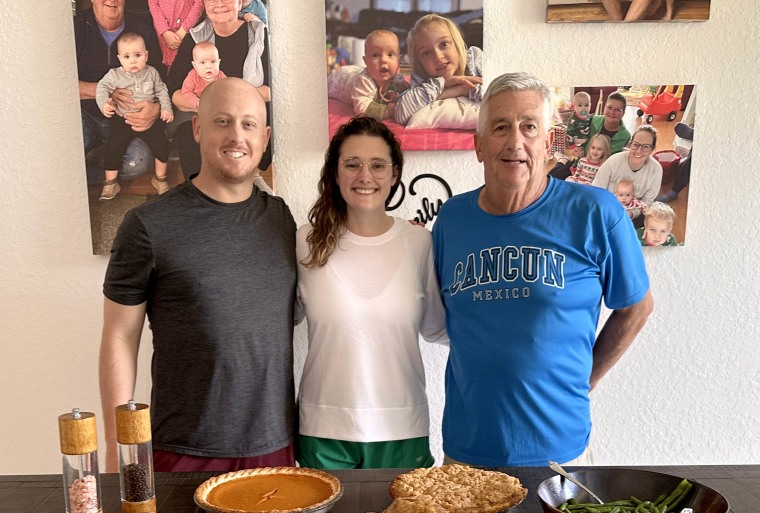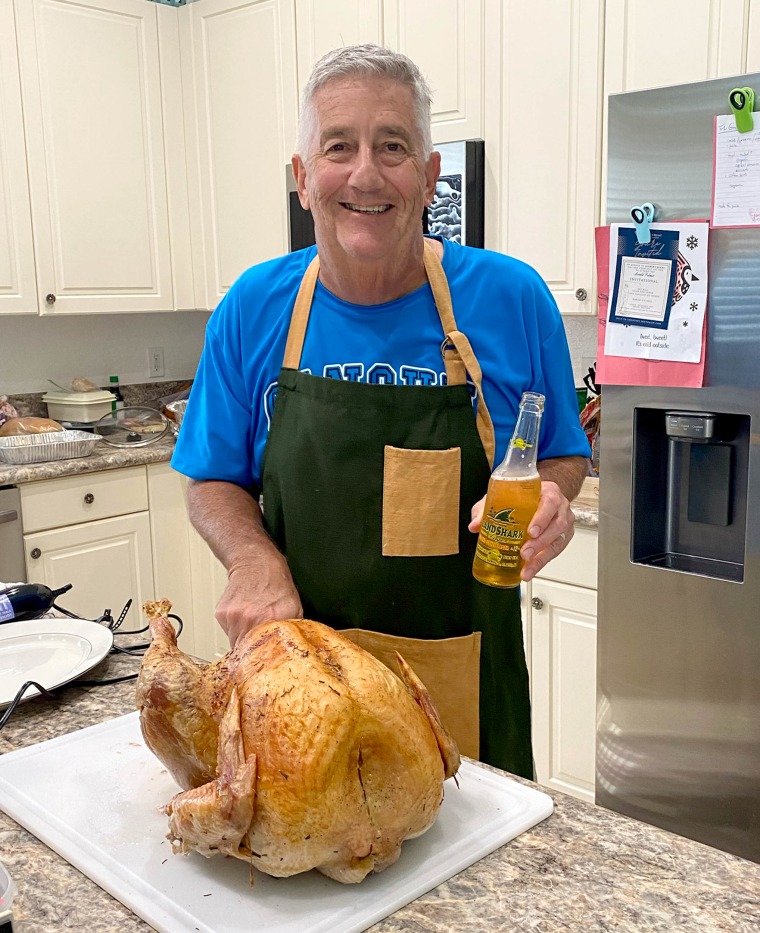Earlier this year, Pat O'Shaughnessy, a 64-year-old retired small business owner, was reflecting on how he wanted to live the rest of his life.
Spending time with his young granddaughter and a recent knee operation led him to get healthier, start walking again and think about the future. So when longtime family friends revealed their daughter's partner, Perry Hess, needed a new kidney, he knew exactly what he wanted to do.
"It all just seemed to fit together," O'Shaughnessy tells TODAY.com. "It was like fate was calling me."
Hess, 31, was born with only one functioning kidney and has lived with chronic kidney disease for pretty much his entire life, he tells TODAY.com.
As a kid, it didn't impact him too much. "Aside from the doctor's visits every six months, I lived a pretty normal life (and had) no real restrictions," he says. But when he got into his teen years, his situation started to become more serious and he began working with specialists.
Hess always knew a kidney transplant was inevitable at some point, he explains. But his doctors tried to delay that for as long as possible. And, ideally, they hoped to get him a new kidney before he needed dialysis.
"The goal was to try to live a fulfilling life and then, later, need a transplant," Hess says. "But that just didn't happen."
His situation began to deteriorate in the last few years and, in August 2022, he started dialysis.
Hearing that, a little over six months ago, Hess still hadn't received a kidney, O'Shaughnessy stepped up to the plate. "My heart was telling me (what to do)," he says. "And it didn't take my heart long to convince my brain."
Without telling Hess, O'Shaughnessy started the process of donating his kidney
O'Shaughnessy, who lives in Danville, Illinois, started filling out the paperwork online that night, which was a "long, tedious process" that required him to provide medical histories for himself and his eight siblings, he recalls.
Two days later, a nurse reached out to him and spent 90 minutes on the phone going over the process. Over the next few weeks, O'Shaughnessy says he spoke with six or seven personnel, including physician assistants, social workers, nurses and scheduling staff.
But he wasn't discouraged. "The whole time, my attitude and my will to do this kept getting stronger and stronger," he says.
Finally, this past October, O'Shaughnessy went to the Mayo Clinic in Jacksonville, Florida, for three days of screening tests and meetings. "It was intense," he says. "Just about any medical test you can think (of), they did."
His first day started at 8 a.m. with the staff taking 28 vials of blood for bloodwork, O'Shaughnessy says, and they handed him a "24-hour urine bucket" to carry around for the day. He met with a psychiatrist and also underwent imaging tests.
On the final day of testing, O'Shaughnessy was on the treadmill for a stress test when his phone rang. He saw it was a call from the Mayo Clinic and thought, "Well, that's strange. They know where I am."
After the test, O'Shaughnessy met with his nurse and received some startling news.
"He said, 'Pat, you're doing great but you're you're not going to donate your kidney to Perry — or to anybody,'" O'Shaughnessy recalls. The screening tests revealed that O'Shaughnessy had cancer, and an avocado-sized tumor was sitting on the kidney that he would have donated.

A surprise diagnosis stopped the process in its tracks.
"My wife and I were both in a bit of shock," he says. "And I was also extremely disappointed that I failed in my mission to get that kidney to Perry."
At the same time, the urologist reminded O'Shaugnessy that he was lucky they found the cancer in its early stages. O'Shaughnessy's generosity and selfless act to help someone else ended up saving his own life, they told him.
About 30% of people who have kidney cancer will die from it, Dr. David Thiel, urologist at the Mayo Clinic, tells TODAY.com. “And they can spread almost anywhere,” he adds.
But because kidney cancer typically doesn’t cause noticeable symptoms in its early stages, it’s frequently found incidentally while people undergo testing for other reasons, Thiel says.
"And they recommended that we have the kidney removed yesterday," O'Shaughnessy recalls. A little over a week later, he and his wife drove back to the Mayo Clinic to meet with his surgeon, Thiel.
Originally, the plan was to remove O'Shaughnessy's kidney via robotic surgery. But based on the size and location of the tumor, it was possible to remove the tumor while leaving much of the kidney intact, Thiel says.
The next day, on Halloween, O'Shaughnessy had the surgery — and it was a success. "He saved two-thirds of the kidney and my life would return to normal in six to eight weeks," O'Shaughnessy recalls.
He didn't need radiation or chemotherapy, Thiel says, but he will need to have regular screening for at least the next five years to keep an eye out in case the cancer returns.
Thankfully, situations like O'Shaughnessy's are relatively rare, Dr. Shennen Mao, a Mayo Clinic transplant surgeon familiar with his case, tells TODAY.com. Finding a cancer diagnosis during the donation process is exceptionally rare, “but we have had donors that have been found to have kidney cancers, lung cancers and breast cancers,” she says.
"I tell our donors that (the donation screening process) is a little bit like taking your car in for a checkup," Mao says. You might take it in for an oil change and end up finding something else isn't quite right.
In O'Shaughnessy's case, "coming forward as a donor really led to an early diagnosis on his behalf," she says, and it prevented a potentially dangerous donation from taking place.

Hess — and more than 100,000 other people in the U.S. — are still waiting on organ donations.
After getting his diagnosis, O'Shaughnessy revealed to Hess that he was trying to be a donor — and thanked Hess for saving his life.
"Your situation tugged at my heart," he told Hess, "and those tests happened to show that I had cancer. And because I was doing those tests for you, Perry, you saved my life."
At first, Hess and his partner, Kaitie, were shocked to hear the news, thinking that it sounded like the type of story they might see on social media. “In wanting to help me, (he) saved himself,” Hess says. “I just think that’s incredible. It speaks volumes to the type of person that he is.”
Two weeks after his surgery, O'Shaughnessy's recovery was going well. He was walking again (at a faster pace than his wife would like, he jokes), and was looking forward to an early morning tee time when he was able to swing a golf club again.
But, as grateful as he was, the fact that Hess still needed a kidney — along with many other people waiting for organs in the U.S. — continued to weigh on him. There are 103,327 adults and children on the national transplant waitlist, according to the Health Resources and Services Administration.
"The limiting factor in life-saving transplants right now is the organs themselves," Thiel says.
"If it's ever crossed your mind, I encourage everyone to consider reaching out as possible kidney donors," Mao agrees.
It wasn't a difficult choice at all for O'Shaughnessy. And, more than anything, he hopes his story convinces others that they can take the same leap.
"I've had a great life, great career, great marriage, three great kids and four adorable grandkids. Perry and Kaitie deserve that same chance," he says. "I didn't make it, but others can. And I'd like to open the door to others who have that same generous heart."